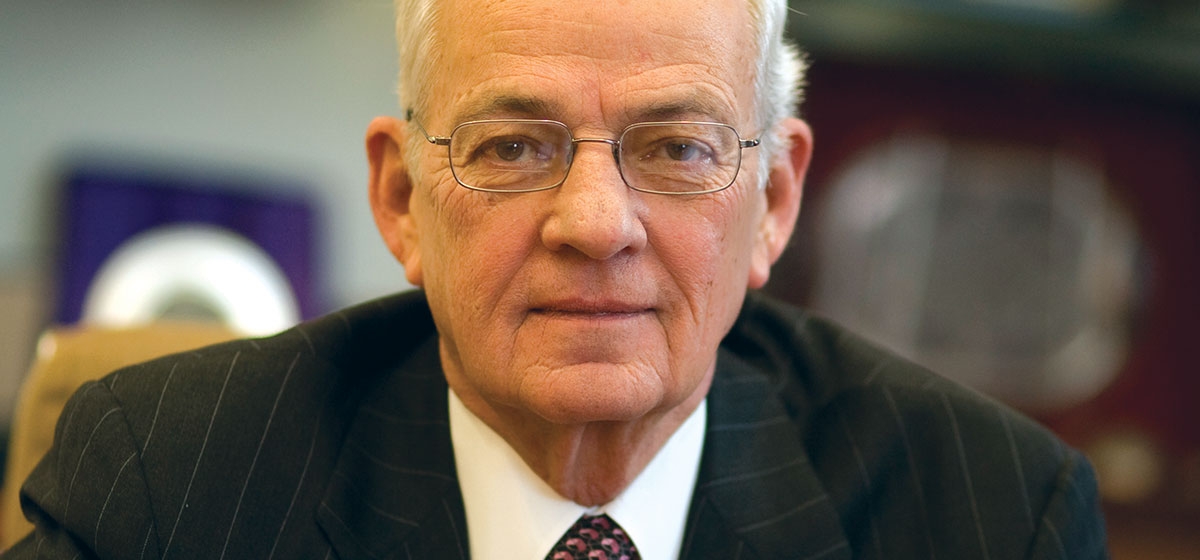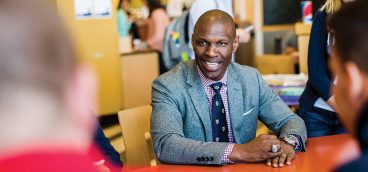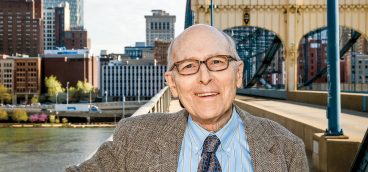
Facts and knowledge have always been important to me, in government and in business. I believe that it is my duty to either know the answers or to know where to get the answers fast if an important decision must be made.
I first entered government when John Kennedy was president, and I was there through Johnson, Nixon and Ford. When there’s a new incoming administration, especially of a different party, many things don’t stop for the political process. I was the outgoing transition person for the Gerald Ford administration, doing the hand-off to Jimmy Carter’s people. A lot of information had to be transferred to the inbound staff, whether they appreciated it or not. It’s important to have a meaningful hand-off that’s not politically skewed. That’s what I offered them.
I left government work in 1977 to take a vice president’s job with International Paper. From there, I went on to Alcoa. But I knew a lot of people in government during the Carter days and I served on the Presidential Commission on Productivity during the Reagan administration. I helped to create the national education goals during the administration of George H. W. Bush. And I knew Bill Clinton from when he was governor of Arkansas (International Paper had some operations there). I’ve had lots of cross-traffic with people in important governmental positions. So, even when I was in the private sector, I stayed involved with national policy issues.
In 2001, after a 24-year hiatus, I went back to government, but it wasn’t the government I remembered. Things were very different under George W. Bush. International relations? Bad. Tax policy? Horrible. He’s done a lot of damage to the country. We’re in a bad place now. But we will get a honeymoon period, and if whoever is elected president in 2008 uses it skillfully, people who are inclined to be supportive of the U.S. will write off Bush as an aberration. True, people who are not so inclined will require a lot of convincing. But the right person could get it done. Unfortunately, those who are running for president this year, while not identical, aren’t substantially different from each other. The likelihood is high that we’re going to get more of the same—more sloth and an unwillingness to tell people the truth about where we are as a nation.
Paul O’Neill Sr.
Executive
- U.S. Secretary of the Treasury (2001-2002)
- Chairman, Alcoa (2000); Chairman and CEO, Alcoa (1987-1999)
- President, International Paper Company (1985-87)
I was born in a U.S. Army hospital in Jefferson Barracks, Missouri. My father was a sergeant in the Army. He got out in 1937 and rejoined in July 1941, when I was not quite 6. During the war, we lived in Scottfield, Ill., where he was stationed. After the war, we moved to Hawaii for a couple of years, then to New Mexico, then to California for awhile, and then to Alaska. So there was a lot of going to new places and meeting new people.
During the summer after my junior year in high school, I worked for the Alaska Road Commission when Alaska was still a territory. I was recruited to be part of a survey crew, which meant a lot of lab and office work converting field observation data into information that was used to locate roads in Alaska. It was something for which I had a natural affinity. In the fall of 1954, I decided on the spur of the moment that I probably should go to college. I hadn’t really made any application, but one of our family’s stopping points over the years was Fresno, Calif., so I decided to go to Fresno State. I took the entrance exam and was admitted. Tuition was $32 a semester, which fit well with my circumstances.
In the early spring of 1955, I got a letter from the Road Commission. The weather was improving faster than usual, so they planned to begin their work in March and wanted me to come back. I thought, this college stuff is OK, but I don’t think I’m getting any value out of it. So I quit school and went back to Alaska. After a month or so, my boss wanted to send me to a place 200 miles from Anchorage for a summer of working in the boondocks. I didn’t want to do that, so I headed over to talk to a little construction company that had major contracts with Fort Richardson Army Post, and they hired me. I went to work for Kincaid and King, doing the same kind of thing—locating streets, roads and so on, as part of a survey team. Soon they made me the office engineer. I took all of the stuff the survey groups were bringing in and put it into a form that we could use.
That September, my wife and I got married. When we came back from our honeymoon in California, Kincaid and King’s work was coming to a winter stop. A fellow that I knew told me that his company had a huge contract to build communication sites all over Alaska. Long story short, I signed on with them as a site engineer. They were within 20 miles of Anchorage. It was made in heaven for me. We finished our construction ahead of time and under budget, so they made me the traveling site engineer for all 33 sites that were being built. I helped all of the on-site engineers get their sites completed under budget and ahead of schedule. I was good at that.
They were paying me a lot of money for a kid without a college degree. One thousand dollars a month was a lot in the mid-1950s. In May 1957, I was working for their top engineer who also happened to be the vice chairman of the board of regents of the University of Alaska. He called me in and said, “You’re doing great. You’re probably going to get rich, but you have to stop doing this and go back to school. Education will change the way you think about the contributions you could make in the future.”
My wife and I thought that he was probably right. So in September, I quit being a site engineer and we went back to California. Between September 1957 and June 1960, I finished my undergraduate degree at Fresno State and got a fellowship to Claremont Graduate School to enter a doctoral program in economics. I worked full-time as a grocery clerk while going to school full-time, too—for $2.35 an hour.
In the spring of 1961, a friend of mine at Claremont told me that he was going to take a particular written examination. It was part of the federal entrance exam, the management intern option, which doesn’t exist any more in that form. In those days, about 300,000 people a year took the written exam. About 3,000 of those were invited to take the oral exam, and about 300 of those were offered assignments at the middle-rank of government service. I was one of the 300 that year and had offers from a bunch of different agencies and departments of the federal government. I ended up at the Veterans Administration because the first year or so of its internship involved going to a computer programming and systems analysis school at IBM. This was at the time when information technology was beginning to happen. I thought that the combination of an economics education, experience in engineering and operations research training, and a computer and systems analysis capability would be a good combination to have. We went to Washington in July 1961 and I started a 15-year career, beginning as a civil servant.
In 1965, I won a National Institute of Public Affairs Scholarship. They paid my full salary and gave me an honorarium to go to another year of graduate school. When I came back from that, the Bureau of the Budget (B.O.B.) was recruiting. Lyndon Johnson was president and he told the person who was then the director that he wanted the B.O.B. to create a capability in domestic activities for the government that was similar to what Bob McNamara was doing in the defense department—using systems analysis to help frame and make decisions about important public policy issues.
I was one of the first people they recruited because of my background in economics, operations research and information technology. I was hired as a program planning and budgeting specialist.
At that point, I was about 31, at a level where most people were 55 or so. They gave me assignments to think about how to make public policy decisions, particularly in health and medical care issues, and I was really good at it. I’d been there for a year when the director came in to the annual budget review meetings on the health and medical care issues. He looked at my work and, for the first time, thought he had some understanding of how to think about these things.
I kept getting promotions. In 1969, a new assistant director was appointed to oversee domestic policy issues and, after he’d been there a couple of weeks, he wanted me to work for him. About six months later, he made me the top career service person responsible for all human resource programs. Then when he went to the Department of Health, Education and Welfare (H.E.W.) around 1971, George Shultz came in. After George had been there a short time, he asked me to take responsibility for all of the domestic programs and budgets for the president. I know that it’s possible to create an analytic framework to enable us to think about where we are as a nation. You begin by organizing information and looking at it on local, state and national levels. You also look at it vis-à-vis what’s going on in other countries around the world. What kinds of financial woes are associated with governmental decisions? What’s happening in non-profit organizations? What’s going on in the private sector? Then you begin to devise a hypothesis.
If we did more of this, it would have this kind of a consequence for this fraction of the population. This is where the money would come from. This is what it would mean in terms of tax policy from the point of view of individuals and geography and institutions. You can make it into something that’s a lot more than political push-and-shove.
In the earlier time that I was in government, there was a lot of weight given to facts and analysis and a lot less weight given to political ideology and that had a big impact on how we allocated money and how it was used. I think we’ve lost our way over time. What I see is a bipartisan slouching towards sloth.






